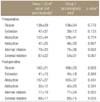Abstract
Purpose
Type II superior labral anterior posterior (SLAP) lesions can occur in the setting of impingement syndrome. The authors compared the clinical results of patients who had undergone either an isolated acromioplasty or a combined type II SLAP repair and acromioplasty.
Materials and Methods
Between 2003 and 2008, a total of 75 cases of SLAP II lesions associated with impingement syndrome were recruited. In 39 patients, the type II SLAP lesion was repaired and acromioplasty was performed. In the other 35 patients, acromioplasty was performed alone. All patients were evaluated using the American Shoulder and Elbow Surgeons (ASES) questionnaire and range of motion.
Results
At an average of 33 months postoperatively, the ASES scores significantly increased in both groups (p<0.001) but the ASES score was similar in the 2 groups (p=0.278). However, there was a significant difference in the ASES scores when the competitive sports activity of the 2 groups of patients postoperatively were compared (p=0.014). The SLAP repair patients showed limited external rotation motion compared to the acromioplasty alone patients (p=0.026).
Figures and Tables
Figure 1
Mean ASES before and after surgery of acromioplasty with or without SLAP repair. After surgery, ASES increased, but there was no significant difference between SLAP repair group and no SLAP repair group postoperatively.

Figure 2
There was significant difference between SLAP repair group and no SLAP repair group in competitive sports group. However, the other groups showed no significant difference.

References
1. Snyder SJ, Karzel RP, Del Pizzo W, Ferkel RD, Friedman MJ. SLAP lesions of the shoulder. Arthroscopy. 1990. 6:274–279.

2. Maffet MW, Gartsman GM, Moseley B. Superior labrumbiceps tendon complex lesions of the shoulder. Am J Sports Med. 1995. 23:93–98.

3. Snyder SJ, Banas MP, Karzel RP. An analysis of 140 injuries to the superior glenoid labrum. J Shoulder Elbow Surg. 1995. 4:243–248.

4. Samani JE, Marston SB, Buss DD. Arthroscopic stabilization of type II SLAP lesions using an absorbable tack. Arthroscopy. 2001. 17:19–24.

5. Rhee YG, Lee DH, Lim CT. Unstable isolated SLAP lesion: clinical presentation and outcome of arthroscopic fixation. Arthroscopy. 2005. 21:1099.

6. Paxinos A, Walton J, Rütten S, Müller M, Murrell GA. Arthroscopic stabilization of superior labral (SLAP) tears with biodegradable tack: outcomes to 2 years. Arthroscopy. 2006. 22:627–634.

7. O'Brien SJ, Allen AA, Coleman SH, Drakos MC. The transrotator cuff approach to SLAP lesions: technical aspects for repair and a clinical follow-up of 31 patients at a minimum of 2 years. Arthroscopy. 2002. 18:372–377.
8. Coleman SH, Cohen DB, Drakos MC, et al. Arthroscopic repair of type II superior labral anterior posterior lesions with and without acromioplasty: a clinical analysis of 50 patients. Am J Sports Med. 2007. 35:749–753.
9. Michener LA, McClure PW, Sennett BJ. American shoulder and elbow surgeons standardized shoulder assessment form, patient self-report section: reliability, validity, and responsiveness. J Shoulder Elbow Surg. 2002. 11:587–594.

10. Kim TK, Queale WS, Cosgarea AJ, McFarland EG. Clinical features of the different types of SLAP lesions: an analysis of one hundred and thirty-nine cases. J Bone Joint Surg Am. 2003. 85-A:66–71.
11. Baysal D, Balyk R, Otto D, Luciak-Corea C, Beaupre L. Functional outcome and health-related quality of life after surgical repair of full-thickness rotator cuff tear using a mini-open technique. Am J Sports Med. 2005. 33:1346–1355.

12. Gartsman GM, Khan M, Hammerman SM. Arthroscopic repair of full-thickness tears of the rotator cuff. J Bone Joint Surg Am. 1998. 80:832–840.

13. Jost B, Pfirrmann CW, Gerber C, Switzerland Z. Clinical outcome after structural failure of rotator cuff repairs. J Bone Joint Surg Am. 2000. 82:304–314.

14. Pandya NK, Colton A, Webner D, Sennett B, Huffman GR. Physical examination and magnetic resonance imaging in the diagnosis of superior labrum anterior-posterior lesions of the shoulder: a sensitivity analysis. Arthroscopy. 2008. 24:311–317.

15. Cohen DB, Coleman S, Drakos MC, et al. Outcomes of isolated type II SLAP lesions treated with arthroscopic fixation using a bioabsorbable tack. Arthroscopy. 2006. 22:136–142.

16. Lim MH, Chan BK, Low CO. Arthroscopic management of superior labral anterior and posterior (SLAP) and associated lesions: clinical features and functional outcome. Ann Acad Med Singapore. 2008. 37:44–48.
17. Ozbaydar MU, Tekin C, Kocabas R, Yalaman O. Arthroscopic treatment of type 2 superior labrum anterior posterior lesions. Acta Orthop Traumatol Turc. 2006. 40:349–355.
18. Panossian VR, Mihata T, Tibone JE, Fitzpatrick MJ, McGarry MH, Lee TQ. Biomechanical analysis of isolated type II SLAP lesions and repair. J Shoulder Elbow Surg. 2005. 14:529–534.

19. Park JH, Lee YS, Wang JH, Noh HK, Kim JG. Outcome of the isolated SLAP lesions and analysis of the results according to the injury mechanisms. Knee Surg Sports Traumatol Arthrosc. 2008. 16:511–515.





 PDF
PDF ePub
ePub Citation
Citation Print
Print




 XML Download
XML Download